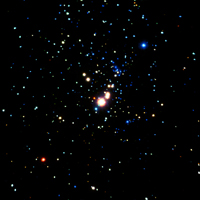NASA’S Chandra S-ray observatory catches x-ray super-flares

This Chandra image shows the Orion Nebula Cluster, a rich cluster of young stars observed almost continuously for 13 days.
Planetary protection: X-ray super-flares aid formation of ’solar systems’
New results from NASA’s Chandra X-ray Observatory about the Orion Nebula imply super-flares torched our young solar system. Such X-ray flares likely affected the planet-forming disk around the early sun, and may have enhanced the survival chances of Earth.
By focusing on the Orion Nebula almost continuously for 13 days, a team of scientists used Chandra to obtain the deepest X-ray observations ever taken of any star cluster. The Orion Nebula is the nearest rich stellar nursery, located just 1,500 light years away from Earth. The Orion Nebula provides an unparalleled view of 1,400 young stars, 30 of which are prototypes of the early sun. Scientists have discovered these young stars erupt in enormous flares that dwarf, in energy, size and frequency, anything seen from our sun today. “We don’t have a time machine to see how the young sun behaved, but the next best thing is to observe sun-like stars in Orion,” said Scott Wolk of Harvard-Smithsonian Center for Astrophysics in Cambridge, Mass. “We are getting a unique look at stars between one and 10 million years old – a time when planets form.”
A key finding is the more violent stars produce flares one hundred times as energetic as the more docile ones. This difference may specifically affect the fate of planets that are relatively small and rocky, like the Earth. “Big X-ray flares could lead to planetary systems like ours, where Earth is a safe distance from the sun,” said Eric Feigelson of Penn State University in University Park. He is the principal investigator for the international Chandra Orion Ultradeep Project. “Stars with smaller flares, on the other hand, might end up with Earth-like planets plummeting into the star.”
According to recent theoretical work, X-ray flares can create turbulence when they strike planet-forming disks, and this affects the position of rocky planets as they form. Specifically, this turbulence can help prevent planets from rapidly migrating towards the young star. “Although these flares may be creating havoc in the disks, they ultimately could do more good than harm,” said Feigelson. “These flares may be acting like a planetary protection program.”
About half of the young suns in Orion show evidence of planet-forming disks including four lying at the center of proplyds (proto-planetary disks) imaged by NASA’s Hubble Space Telescope. X-ray flares bombard these disks, likely giving them an electric charge. This charge, combined with motion of the disk and the effects of magnetic fields, should create turbulence in the disk.
The numerous results from the Chandra Orion Ultradeep Project will appear in an upcoming issue of The Astrophysical Journal Supplement. The team contains 37 scientists from institutions in the U.S., Italy, France, Germany, Taiwan, Japan and the Netherlands.
Media Contact
More Information:
http://www.cfa.harvard.eduAll latest news from the category: Physics and Astronomy
This area deals with the fundamental laws and building blocks of nature and how they interact, the properties and the behavior of matter, and research into space and time and their structures.
innovations-report provides in-depth reports and articles on subjects such as astrophysics, laser technologies, nuclear, quantum, particle and solid-state physics, nanotechnologies, planetary research and findings (Mars, Venus) and developments related to the Hubble Telescope.
Newest articles

Scientists transform blood into regenerative materials
… paving the way for personalized, blood-based, 3D-printed implants. Scientists have created a new ‘biocooperative’ material based on blood, which has shown to successfully repair bones, paving the way for…

A new experimental infection model in flies
…offers a fast and cost-effective way to test drugs. Researchers at the Germans Trias i Pujol Research Institute and Hospital have reinforced their leading role in infectious disease research by…

Material developed with novel stretching properties
KIT researchers produce metamaterial with different extension and compression properties than conventional materials. With this material, the working group headed by Professor Martin Wegener at KIT’s Institute of Applied Physics…



